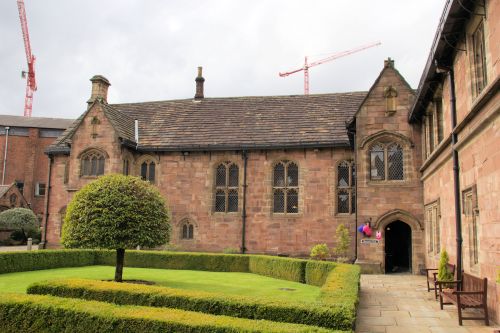Robin Hood's Arrows (Chetham's Library)
| Locality | |
|---|---|
| Coordinate | 53.486604, -2.243777 |
| Adm. div. | Lancashire |
| Vicinity | Long Millgate, Manchester |
| Type | Artifact |
| Interest | Artifacts |
| Status | Defunct |
| First Record | 1827 |

By Henrik Thiil Nielsen, 2019-03-02. Revised by Henrik Thiil Nielsen, 2021-01-07.
Until the mid-19th century, Chetham's Library included a veritable cabinet of curiosities, among whose highlights – as they must seem to us – were several 'arrows [that] once belonged to Robin Hood'. Some time before 1866 most of this assortment of knick knack was gifted to Salford Museum and Art Gallery, which opened in 1850.[1] This new cultural institution cannot have been too happy with its mass-acquisition, for the collection was further disbanded, and the present whereabouts of many objects are unknown.[2] For more about the collection, see the page on 1827 - Gregson, J S - Museum Chethamiense.
It was one of the duties of the 'blue-coat' boys from the 'Hospital', a charity school founded in tandem with Chetham's library, to act as cicerones to visitors when summoned by a bell. This they apparently did by rattling off a memorized list of objects on display, an 'oral catalogue' to which they sometimes made extemporized additions, retroactively foisting humdrum items in the collection on Oliver Cromwell, Elizabeth I, Robin Hood or whomever they thought might add a little lustre to the overly mundane. One can almost hear their schoolboy laughter. A researcher at the library includes Robin Hood's arrows among the objects possibly given such a fictitious provenance, and presumably this indicates that she has found no evidence they had been bequeathed to the library accompanied by a note of their having belonged to the famous outlaw.
The library was still receiving curios in 1838,[3] and by coincidence a set of alleged Robin Hood's arrows previously displayed to customers at Robin Hood's Well (Nottingham) are said to have been auctioned off in 1827 – the very year in which the Oral Catalogue of the collection of objects at Chetham's Library was perpetuated in print – to a Lionel Raynor, an actor on the London stage, who seems later to have been intent on finding a home for his little collection before migrating to America. However, if the latter story is correct, these arrows could not have found their way to Manchester soon enough to be the ones referred to in the catalogue.
Allusions
1827 - Gregson, J S - Museum Chethamiense
Gazetteers
- Not included in Dobson, R. B., ed.; Taylor, J., ed. Rymes of Robyn Hood: an Introduction to the English Outlaw (London, 1976), pp. 293-311.
Background
Also see
- Manchester place-name cluster
- Unique artifacts
- Robin Hood's Arrows (Robin Hood's Well, Nottingham)
- Robin Hood's Well (Nottingham).
Notes
- ↑ See 1827 - Gregson, J S - Museum Chethamiense.
- ↑ Chetham's Library: Curioser and Curioser.
- ↑ Chetham's Library: Curioser and Curioser; for item received 1838, see the fourth photo in the text.
- ↑ Swindells, T. Manchester Streets and Manchester Men. Fifth Series (Manchester, 1908), pp. 35-36.
